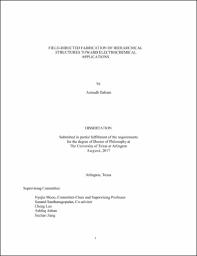
ATTENTION: The works hosted here are being migrated to a new repository that will consolidate resources, improve discoverability, and better show UTA's research impact on the global community. We will update authors as the migration progresses. Please see MavMatrix for more information.
Show simple item record
| dc.contributor.advisor | Moon, Hyejin | |
| dc.contributor.advisor | Santhanagopalan, Sunand | |
| dc.creator | Balram, Anirudh | |
| dc.date.accessioned | 2019-04-10T21:49:37Z | |
| dc.date.available | 2019-04-10T21:49:37Z | |
| dc.date.created | 2017-08 | |
| dc.date.issued | 2017-08-25 | |
| dc.date.submitted | August 2017 | |
| dc.identifier.uri | http://hdl.handle.net/10106/27960 | |
| dc.description.abstract | The ubiquity of hierarchical structures in nature indicates an inherent advantage to having morphological features comprised of multiple length scales. Such structures help maximize interfacial surface area, allowing for efficient chemical reactions and mass transport despite volumetric constraints. In electrochemical applications such as batteries, supercapacitors, electrolysis, fuel cells, catalysis etc. there is a similar necessity to maximize electrochemically active surface area to facilitate facile charge and mass transport. Inspired by examples in nature, this work seeks to develop scalable fabrication techniques to obtain hierarchically structured high-performance electrodes for electrochemical applications, with a focus on energy applications. Particular emphasis was laid on improving oxygen evolution reaction and hydrogen evolution reaction catalyst performance in alkaline electrolytic water splitting, an extremely promising technology for a sustainable clean energy future. Utilizing field-directed nanomaterial assembly techniques such as electrophoretic deposition, electrodeposition, and magnetophoresis, a variety of carbon nanotube, metal and mixed-metal hydroxide based hierarchical nanocomposites geared towards superior electrochemical performance were prepared. By virtue of the intimate attachment between various components within the deposits, synergistic performance enhancements could be exploited, greatly reducing water splitting overpotentials. Such high performance catalysts produced with earth abundant materials are critical to the large-scale viability of this technology. Additionally, these field-directed assembly techniques offer control over nanomaterial orientation in the deposits. Through rational choice of deposition technique, deposition parameters, and material selection, extreme surface wetting properties such as superhydrophobicity, superhydrophilicity, underwater superaerophobicity and superoleophobicity could be induced in some of the deposits. The ideas demonstrated in this work are broadly applicable toward the improvement of a variety of next generation electrochemical applications. | |
| dc.format.mimetype | application/pdf | |
| dc.subject | Electrophoretic deposition | |
| dc.subject | Oxygen evolution reaction | |
| dc.subject | Hydrogen evolution reaction | |
| dc.subject | Electrodeposition | |
| dc.subject | EPD | |
| dc.subject | OER | |
| dc.subject | HER | |
| dc.subject | Water splitting | |
| dc.subject | Electrolysis | |
| dc.subject | Carbon nanotubes | |
| dc.subject | Nickel hydroxide | |
| dc.subject | Amorphous | |
| dc.subject | Catalyst | |
| dc.title | FIELD-DIRECTED FABRICATION OF HIERARCHICAL STRUCTURES TOWARD ELECTROCHEMICAL APPLICATIONS | |
| dc.type | Thesis | |
| dc.degree.department | Mechanical and Aerospace Engineering | |
| dc.degree.name | Doctor of Philosophy in Mechanical Engineering | |
| dc.date.updated | 2019-04-10T21:51:47Z | |
| thesis.degree.department | Mechanical and Aerospace Engineering | |
| thesis.degree.grantor | The University of Texas at Arlington | |
| thesis.degree.level | Doctoral | |
| thesis.degree.name | Doctor of Philosophy in Mechanical Engineering | |
| dc.type.material | text | |
| dc.creator.orcid | 0000-0002-8755-6663 | |
Files in this item
- Name:
- BALRAM-DISSERTATION-2017.pdf
- Size:
- 35.30Mb
- Format:
- PDF
This item appears in the following Collection(s)
Show simple item record


